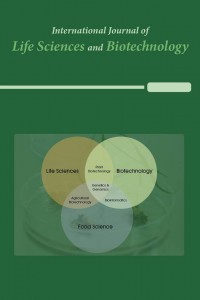Karbohidrat Bazlı Terapotikler
Karbohidrat, Hastalık, Terapotik, Glikan
Carbohydrate Based Therapeutics
Carbohydrate, Therapeutic, Disesase, Glycan,
___
- 1. Axford, J., Glycobiology and medicine: an introduction. Journal of the Royal Society of Medicine, 1997. 90(5): p. 260-264.
- 2. Schnaar, R.L. and H.H. Freeze, A "Glyconutrient Sham" and the Jenner Glycobiology and Medicine Symposium. Glycobiology, 2017. 27(5): p. 383-384.
- 3. Hakomori, S., New directions in cancer therapy based on aberrant expression of glycosphingolipids: anti-adhesion and ortho-signaling therapy. Cancer Cells, 1991. 3(12): p. 461-70.
- 4. Kuberan, B. and R.J. Lindhardt, Carbohydrate based vaccines. Current Organic Chemistry, 2000. 4(6): p. 653-677.
- 5. Jirmo, A.C., et al., Differential expression patterns of glycosphingolipids and C-type lectin receptors on immune cells in absence of functional regulatory T cells. Immunity Inflammation and Disease, 2020. 8(4): p. 512-522.
- 6. Liang, Y.J., et al., Differential expression profiles of glycosphingolipids in human breast cancer stem cells vs. cancer non-stem cells. Proceedings of the National Academy of Sciences of the United States of America, 2013. 110(13): p. 4968-4973.
- 7. Cai, Z.X., et al., Shear-thinning hyaluronan-based fluid hydrogels to modulate viscoelastic properties of osteoarthritis synovial fluids. Biomaterials Science, 2019. 7(8): p. 3143-3157.
- 8. Ballut, S., et al., New strategy for targeting of photosensitizers. Synthesis of glycodendrimeric phenylporphyrins, incorporation into a liposome membrane and interaction with a specific lectin. Chemical Communications, 2009(2): p. 224-226.
- 9. Kimura, S., et al., A novel glycan targeting cancer therapy using lectin modified liposome. Cancer Research, 2019. 79(13).
- 10. Joziasse, D.H. and R. Oriol, Xenotransplantation: the importance of the Galalpha1,3Gal epitope in hyperacute vascular rejection. Biochim Biophys Acta, 1999. 1455(2-3): p. 403-18.
- 11. Kosik, I., et al., Correction: Influenza A virus hemagglutinin glycosylation compensates for antibody escape fitness costs. PLoS Pathog, 2018. 14(6): p. e1007141.
- 12. Liu, C.C., X.J. Zheng, and X.S. Ye, Broadly Neutralizing Antibody-Guided Carbohydrate-Based HIV Vaccine Design: Challenges and Opportunities. Chemmedchem, 2016. 11(4): p. 357-362.
- 13. Behrens, A.J., et al., Integrity of Glycosylation Processing of a Glycan-Depleted Trimeric HIV-1 Immunogen Targeting Key B-Cell Lineages. J Proteome Res, 2018. 17(3): p. 987-999.
- 14. Ingale, J., et al., Hyperglycosylated stable core immunogens designed to present the CD4 binding site are preferentially recognized by broadly neutralizing antibodies. J Virol, 2014. 88(24): p. 14002-16.
- 15. Hyakumura, M., et al., Modification of Asparagine-Linked Glycan Density for the Design of Hepatitis B Virus Virus-Like Particles with Enhanced Immunogenicity. J Virol, 2015. 89(22): p. 11312-22.
- 16. McCoy, L.E. and D.R. Burton, Identification and specificity of broadly neutralizing antibodies against HIV. Immunol Rev, 2017. 275(1): p. 11-20.
- 17. Astronomo, R.D., et al., A glycoconjugate antigen based on the recognition motif of a broadly neutralizing human immunodeficiency virus antibody, 2G12, is immunogenic but elicits antibodies unable to bind to the self glycans of gp120. Journal of Virology, 2008. 82(13): p. 6359-6368.
- 18. Wang, Z.Y., et al., Recent advances in synthetic carbohydrate-based human immunodeficiency virus vaccines. Virologica Sinica, 2016. 31(2): p. 110-117.
- 19. Excler, J.L., M.L. Robb, and J.H. Kim, Prospects for a Globally Effective HIV-1 Vaccine. Am J Prev Med, 2015. 49(6 Suppl 4): p. S307-18.
- 20. Rubens, M., et al., HIV Vaccine: Recent Advances, Current Roadblocks, and Future Directions. J Immunol Res, 2015. 2015: p. 560347.
- 21. Mettu, R., C.Y. Chen, and C.Y. Wu, Synthetic carbohydrate-based vaccines: challenges and opportunities. J Biomed Sci, 2020. 27(1): p. 9.
- 22. Brown, G.D., et al., Dectin-1 mediates the biological effects of beta-glucans. J Exp Med, 2003. 197(9): p. 1119-24.
- 23. Pollard, A.J., K.P. Perrett, and P.C. Beverley, Maintaining protection against invasive bacteria with protein-polysaccharide conjugate vaccines. Nat Rev Immunol, 2009. 9(3): p. 213-20.
- 24. Kumpulainen, E.J., R.J. Keskikuru, and R.T. Johansson, Serum tumor marker CA 15.3 and stage are the two most powerful predictors of survival in primary breast cancer. Breast Cancer Res Treat, 2002. 76(2): p. 95-102.
- 25. Locker, G.Y., et al., ASCO 2006 update of recommendations for the use of tumor markers in gastrointestinal cancer. J Clin Oncol, 2006. 24(33): p. 5313-27.
- 26. Sato, Y., et al., Early Recognition of Hepatocellular-Carcinoma Based on Altered Profiles of Alpha-Fetoprotein. New England Journal of Medicine, 1993. 328(25): p. 1802-1806.
- 27. Adamczyk, B., T. Tharmalingam, and P.M. Rudd, Glycans as cancer biomarkers. Biochim Biophys Acta, 2012. 1820(9): p. 1347-53.
- 28. Campos, D., et al., Probing the O-glycoproteome of gastric cancer cell lines for biomarker discovery. Mol Cell Proteomics, 2015. 14(6): p. 1616-29.
- 29. Saldova, R., et al., Core fucosylation and alpha2-3 sialylation in serum N-glycome is significantly increased in prostate cancer comparing to benign prostate hyperplasia. Glycobiology, 2011. 21(2): p. 195-205.
- Yayın Aralığı: Yılda 3 Sayı
- Başlangıç: 2018
- Yayıncı: International Society of Academicians
Molecular Detection of Bacillus cereus in Milk by Polymerase Chain Reaction
Begüm TERZİ AKSOY, Elif BOZKURT, Özlem ATEŞ SÖNMEZOĞLU
Belkis ATASEVER ARSLAN, İdil SATICI, Enes Furkan ARSLAN, Ayşegül YANIK, Seda KUŞOĞLU GÜLTEKİN
Ahmad Yar AHMADİ, Mohammad Jan ARAİN
Genetiği Değiştirilmiş Doğal Bitkiler: Yatay Gen Transferi
Aktif Yara Örtülerinin Eldesinde Fotosensitizerlerin Kullanımı
Gül Merve GENÇER, Murat AKARSU
Mesoporous silica nanoparticles, methods of preparation and use of bone tissue engineering
SARS-CoV-2’nin Hızlı Tespiti İçin Tasarlanan Biyosensörler
Tuğba Begüm KARAKAŞ, İlayda DEMİRDİŞ
Karbohidrat Bazlı Terapotikler
Nebiye Pelin TÜRKER, Elvan BAKAR
Bitki Hastalık Dayanıklılık Proteinleri; İmmün Savunma Molekülleri Olarak R-gen Ürünleri
